Chicken or Egg? by Polly Dunbar
'Where do you get your ideas ?' is the first question I am asked, as an author and illustrator. The second is the eternal 'chicken or egg' question: which comes first, the words or the pictures? I'll try to answer here.
I am fascinated by the third element in the making of a picture book - the special space between the words and pictures into which a child is invited to fill the gap with their own imagination. If allowed, the reader plays an active part in the story, breathing their own life into it; when this happens successfully it's like a tiny explosion in the mind.
These little explosions can trigger all sorts of responses: they can be shocking; they can make you laugh; they can be intriguing. The important part is reaching a conclusion all by yourself rather than have it spoon-fed by the author.
Jon Klassen is a master of balancing words and pictures and leaving us a gap. Here is a picture from his new book THIS IS NOT MY HAT, with a fish that looks very much AWAKE - brilliant!
Because the ending isn't spelled out, the reader has to work out what happens to the narrator fish without being told. The ending you come to in your own mind might be hilarious or horrifying or perhaps it's a completely different ending to the one the author intended; it doesn't matter, what matters is the huge pleasure in getting there with your own imagination.
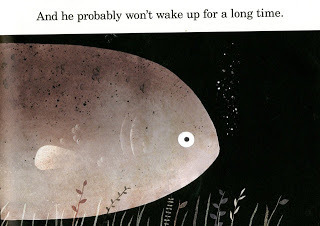
My first published book was a series of cartoons about being a teenager. I was interested in the work of Gary Larson - I loved the way he combines a picture that tells you one thing and a line of text that tells you another: bingo...something absurd...an explosion...usually of laughter!
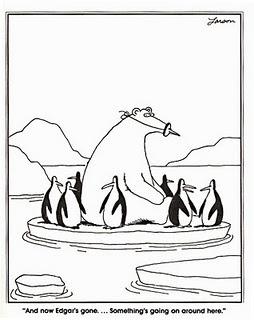
So I started writing/drawing my own cartoons - which turned out to be very good training for writing picture books. It's an exercise in paring down what you are trying to say to its absolute essence, allowing the words and pictures to come together creating a friction or a vibration, like forcing two magnets together that don't want to meet. Synergy.
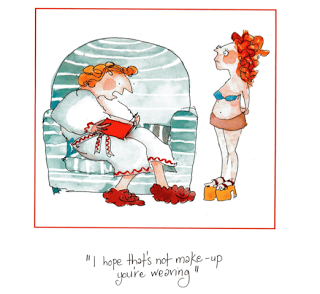
An example of the connection between words and pictures is cleverly done in a series of HCBC adverts, putting different words with the same picture. It is startlingly effective - to have one's mind prompted into making so many different associations to the same picture, making it look or 'feel' different each time.
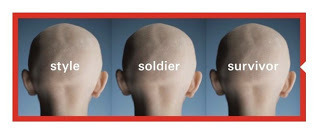
This power between words and pictures is for me what makes picture books so special, why they have a magic that is hard to capture in animation or apps. I'm all for telling stories in different ways using different formats - pictures that move and dance and sing, with buttons to press and things that squeak. Although I love all this, there is infinitely more pleasure in making those pictures dance and sing in one's own mind, to feel those synapses snapping to make it come to life in a way that is unique to you, giving power to the reader.
With my very first picture book 'FLY AWAY KATIE' I had decided I wanted to be an 'author' as well as an illustrator. I set about writing a story that was about 4000 words too long, getting myself into a terrible muddle describing everything that was happening, how the character was feeling on each page. One day I sat down, threw out all the words and just drew the story in a series of pictures...and there I had it. I added a few words to help the story along and left it up to the reader to decide how Katie was feeling.
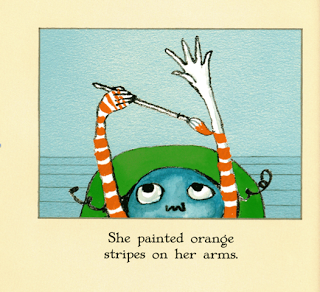
So back to the 'which comes first' question, writing or drawing? Capturing ideas and turning them into stories is an elusive business; the essential elements, of words, picture, idea, never seem to be in the same place twice. I doodle in my sketch books, images, phrases anything that has caught my attention. Sometimes if I'm very lucky a drawing cross-fertilizes with another image or a phrase, and the juxtaposition of two things will create a spark and lead to a story. My book PENGUIN started with this sketch of a toothy penguin and the words 'bit hard very hard on the nose.'
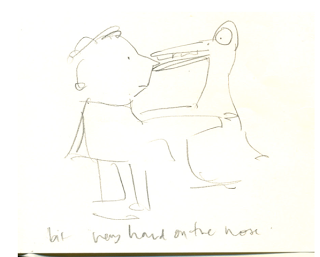
The beauty of being an author/illustrator is that you can prune your own words and let the pictures do the work. Very young children are visually literate and can read body language far earlier than they can read words. On this page in Penguin, I could have described the tantrum that Ben was having, but I didn't need to - , the pictures are enough.
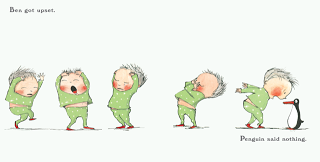
At the end of the book Penguin says 'everything' in pictures alone. At first my editor and I were a bit worried that readers might flounder on this page, with no words to guide them through the story. But rather than leaving the reader stumped, it gives the child a chance to be the storyteller, to bring it to life in their own words.
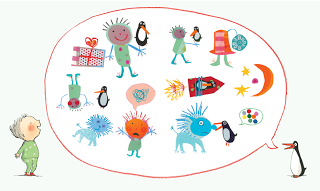
Children's authors don't have to illustrate their own work, they just have to invite the illustrator to dance with them, being careful not to tread on their toes. I'm doing this dance at the moment with my Mum, Joyce Dunbar. She has written a text called PAT-A-CAKE BABY. Mum wrote some words, I did some doodles. Mum wrote more words and we danced chaotically, not sure who was leading until we learnt the steps, and now we're nearly ready to invite people to dance with us.
It doesn't matter which comes first, the pictures or the words, so long as when they come together you can hear an unexpected and wonderful fizzing in the mind of the reader.
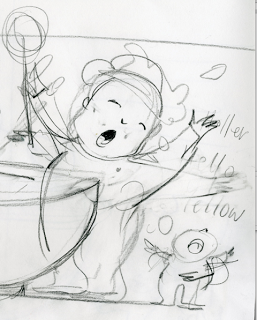
To find out more about guest blogger, Polly Dunbar,please visit http://www.pollydunbar.com/
I am fascinated by the third element in the making of a picture book - the special space between the words and pictures into which a child is invited to fill the gap with their own imagination. If allowed, the reader plays an active part in the story, breathing their own life into it; when this happens successfully it's like a tiny explosion in the mind.
These little explosions can trigger all sorts of responses: they can be shocking; they can make you laugh; they can be intriguing. The important part is reaching a conclusion all by yourself rather than have it spoon-fed by the author.
Jon Klassen is a master of balancing words and pictures and leaving us a gap. Here is a picture from his new book THIS IS NOT MY HAT, with a fish that looks very much AWAKE - brilliant!
Because the ending isn't spelled out, the reader has to work out what happens to the narrator fish without being told. The ending you come to in your own mind might be hilarious or horrifying or perhaps it's a completely different ending to the one the author intended; it doesn't matter, what matters is the huge pleasure in getting there with your own imagination.

My first published book was a series of cartoons about being a teenager. I was interested in the work of Gary Larson - I loved the way he combines a picture that tells you one thing and a line of text that tells you another: bingo...something absurd...an explosion...usually of laughter!

So I started writing/drawing my own cartoons - which turned out to be very good training for writing picture books. It's an exercise in paring down what you are trying to say to its absolute essence, allowing the words and pictures to come together creating a friction or a vibration, like forcing two magnets together that don't want to meet. Synergy.

An example of the connection between words and pictures is cleverly done in a series of HCBC adverts, putting different words with the same picture. It is startlingly effective - to have one's mind prompted into making so many different associations to the same picture, making it look or 'feel' different each time.

This power between words and pictures is for me what makes picture books so special, why they have a magic that is hard to capture in animation or apps. I'm all for telling stories in different ways using different formats - pictures that move and dance and sing, with buttons to press and things that squeak. Although I love all this, there is infinitely more pleasure in making those pictures dance and sing in one's own mind, to feel those synapses snapping to make it come to life in a way that is unique to you, giving power to the reader.
With my very first picture book 'FLY AWAY KATIE' I had decided I wanted to be an 'author' as well as an illustrator. I set about writing a story that was about 4000 words too long, getting myself into a terrible muddle describing everything that was happening, how the character was feeling on each page. One day I sat down, threw out all the words and just drew the story in a series of pictures...and there I had it. I added a few words to help the story along and left it up to the reader to decide how Katie was feeling.

So back to the 'which comes first' question, writing or drawing? Capturing ideas and turning them into stories is an elusive business; the essential elements, of words, picture, idea, never seem to be in the same place twice. I doodle in my sketch books, images, phrases anything that has caught my attention. Sometimes if I'm very lucky a drawing cross-fertilizes with another image or a phrase, and the juxtaposition of two things will create a spark and lead to a story. My book PENGUIN started with this sketch of a toothy penguin and the words 'bit hard very hard on the nose.'

The beauty of being an author/illustrator is that you can prune your own words and let the pictures do the work. Very young children are visually literate and can read body language far earlier than they can read words. On this page in Penguin, I could have described the tantrum that Ben was having, but I didn't need to - , the pictures are enough.

At the end of the book Penguin says 'everything' in pictures alone. At first my editor and I were a bit worried that readers might flounder on this page, with no words to guide them through the story. But rather than leaving the reader stumped, it gives the child a chance to be the storyteller, to bring it to life in their own words.

Children's authors don't have to illustrate their own work, they just have to invite the illustrator to dance with them, being careful not to tread on their toes. I'm doing this dance at the moment with my Mum, Joyce Dunbar. She has written a text called PAT-A-CAKE BABY. Mum wrote some words, I did some doodles. Mum wrote more words and we danced chaotically, not sure who was leading until we learnt the steps, and now we're nearly ready to invite people to dance with us.
It doesn't matter which comes first, the pictures or the words, so long as when they come together you can hear an unexpected and wonderful fizzing in the mind of the reader.

To find out more about guest blogger, Polly Dunbar,please visit http://www.pollydunbar.com/
Published on February 19, 2013 04:47
No comments have been added yet.



